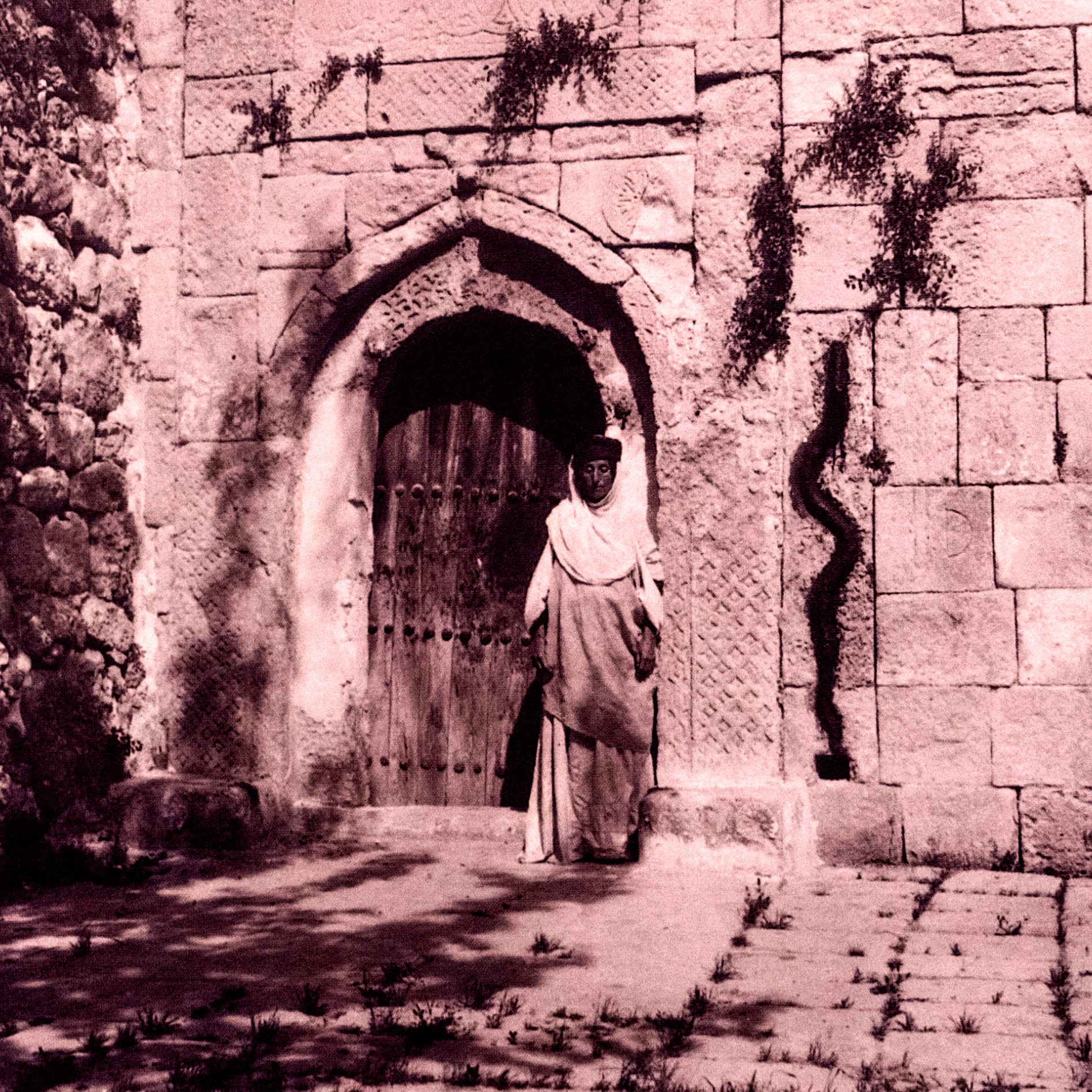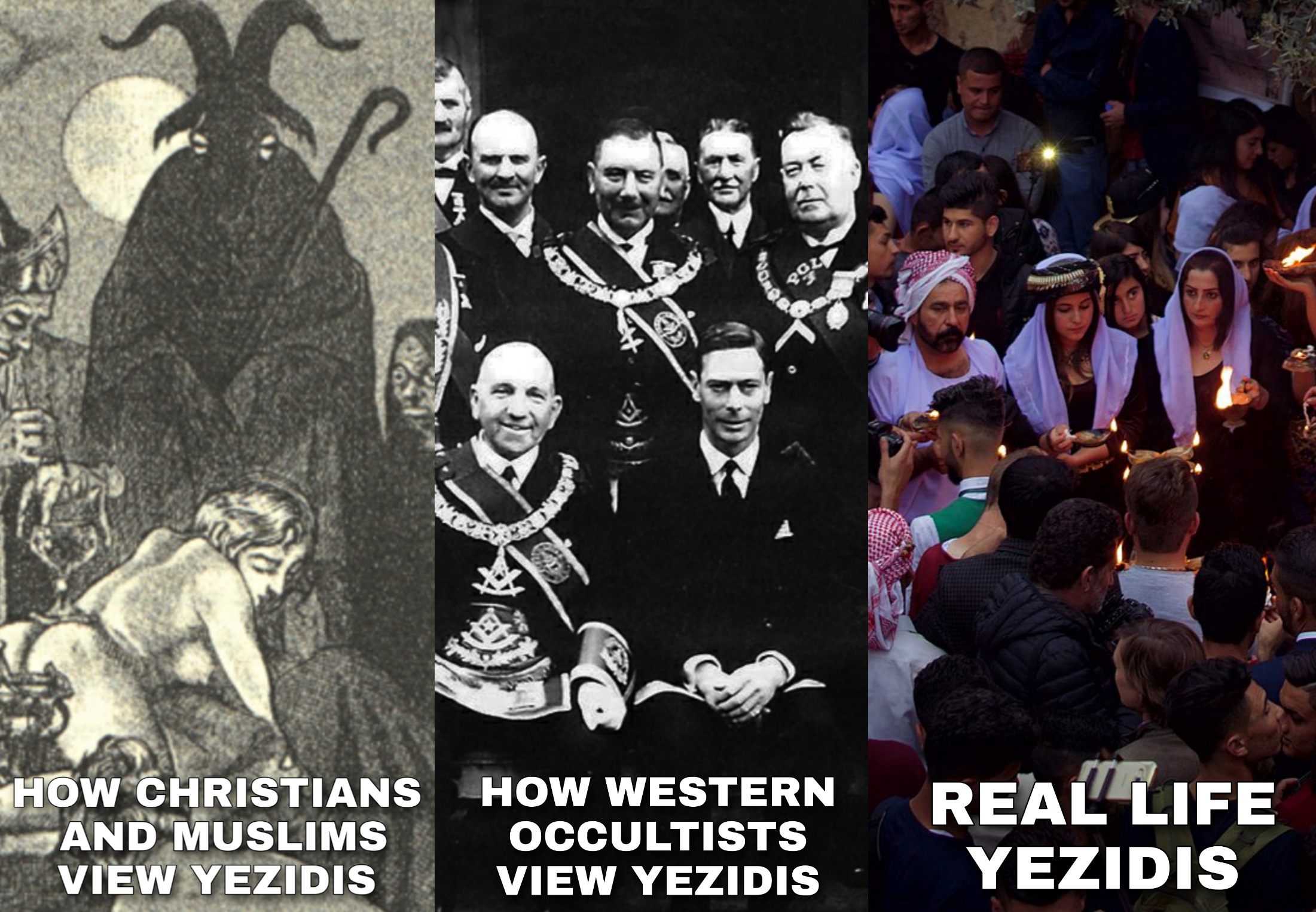The Yezidis are accused of “worshiping the devil,” but are also romanticized by Western occultists—neither of which is acceptable.

I first learned about the Yezidis from reading Terri Hardin’s Supernatural Tales From Around the World in the late 1990s. At that point, most people—including Western scholars—were still calling them “devil worshipers,” and accurate information about this culture was still very hard to come by. It’s only been during the past 15 years or so that the outside world has finally given the Yezidis the proper attention they deserve, but the cause for this is unfortunate. After many centuries of persecution, the Yezidis continue to be systematically slaughtered by Islamic jihadists. They are especially despised by the Islamic State terrorist group, which has exterminated entire crowds of Yezidi men and kidnapped countless Yezidi women and children, forcing them into slavery.
Yezidism is a syncretized religion that combines pre-Zoroastrian Kurdish polytheism with certain elements from the biblical faiths. It revolves around nine theological personas, including: a deistic Creator God who takes little direct interest in mortal affairs; seven archangels that serve as custodians for Creation; and a holy prophet named Sheikh Adi ibn Musafir, who is believed to have been one of the seven archangels in human form. Yezidis believe that worshiping the Creator God is pointless, because this entity does not actually care what happens to mortal beings. Our prayers are more productively directed toward the archangels instead, since they now rule the universe in the Creator’s place. Of these seven angels, the most important is called Melek Taus or Ta’usi-Melek, “the Peacock Angel.”
Melek Taus appears to have been a polytheist deity who was later conflated with the Islamic version of Satan, and this is where the accusation of Yezidi “devil worship” comes from. According to the Koran, Iblis (“Doubt,” the Islamic name for Satan) was originally a genie who refused to prostate himself before Adam per Allah’s command. Iblis is said to have thought he was superior to human beings, and Allah cast him out of heaven for his insolence and pride. Afterwards, Iblis became the Shaitan and devoted himself to tricking as many people into disobeying Allah as possible (so they will go to hell). Aside from this origin story, the Islamic devil functions in much the same way as the Christian devil does; he is basically there to harass, frighten, and/or deceive monotheists into committing various “sins.”
The Yezidis worshiped their peacock God long before they ever heard this story; but at some point, attempts were made to convert them to Islam. They were told that their Peacock Angel is actually the Shaitan (just as all polytheist deities are really “Satan” in monotheist eyes). Strangely, the Yezidis seem to have agreed that Melek Taus is the same person as Iblis; and they do agree that he disobeyed a direct order from the Creator by refusing to worship human beings. But this is where the resemblance between these two narratives ends. The Yezidis believe that instead of becoming the devil, Melek Taus actually became the first monotheist. He disobeyed the Creator not out of pride but out of loyalty, for he was refusing to worship anyone else but the Creator. The Yezidis further hold that Melek Taus was rewarded for this act of disobedience, and that the Creator chose him to rule our cosmos. In this way, they justified the continued worship of their Peacock Angel not as the “enemy” of Allah, but as his regent.
Sheikh Adi ibn Musafir was a medieval Sufi Muslim who traveled to Kurdistan in search of some peace and quiet. Despite his attempts to live a monastic life, he drew the attention of his new Yezidi neighbors, who seem to have thought he was a wizard. Sheikh Adi likely tried converting the Yezidis to Islam (and he was probably one of the very few who ever tried to do this peacefully). As far as I’ve been able to trace, the idea of Iblis being “the first monotheist” originates from the Sufi movement, which follows a more mystical reading of Islam. I bet Sheikh Adi introduced this idea to the Yezidis, who then equated it with their own God Melek Taus. In any case, Sheikh Adi made such an impression on these people that they started to believe he was actually a human incarnation of the Peacock Angel. To this very day, making a pilgrimage to Sheikh Adi’s tomb is still an important component of the Yezidi faith.

Much of the attention Yezidism has received here in the West comes from Satanists, who often cite the religion as “proof” for the historicity of a pre-LaVeyan Satanism. (Nevermind the fact that Anton LaVey was preceded by two earlier 20th century Satanists, Maria de Naglowska and Herbert Sloane.) LaVey even included part of a so-called Yezidi text—the Al-Jilwah—in his book, The Satanic Rituals (Avon, 1972). This text is now accepted by some theistic Satanists as a direct revelation from Lucifer himself; but its true history is far less certain. For one thing, the Al-Jilwah is only part of a longer text called the Mishaf Resh (“Black Book”). And while it does reflect some Yezidi beliefs, it was not written by Yezidis. Back in 2007, I had an opportunity to speak about this with Dr. Philip G. Kreyenbroek (one of the leading scholars of Yezidi culture today), and this is what Dr. Kreyenbroek shared with me:
“The so-called ‘Sacred Books’ are forgeries and have little to do with Yezidi belief. [. . .] I can still remember the face of a learned Yezidi friend of mine when I first showed him the ‘Sacred Books,’ first he was scandalized and then he laughed fit to burst.”
—P.G. Kreyenbroek (Personal Communication, October 20, 2007)
I have met theistic Satanists who believe everything in the Al-Jilwah word-for-word, as if it were the Bible and they were fundamentalist Christians. Yet the truth is that:
- Melek Taus and Satan are two completely different figures.
- Yezidis don’t believe in “Satan” as he is defined in Christianity or Islam at all.
- Yezidis consider the Al-Jilwah to be some Westerner’s idea of a joke.
This pretty much destroys the entire notion of using the Al-Jilwah as some kind of “infallible” sacred scripture. But Yezidi beliefs have also been appropriated by other Western occult groups, including Theosophists and Thelemites . While romanticizing the Yezidis as “ascended occult masters” is much better than vilifying them as “devil worshipers,” it is equally removed from reality. What these people have written about Yezidism really says more about Western occultists than it does about Yezidis. It’s equivalent to saying, “I can’t find more than a single paragraph about the Yezidis in any of my encyclopedias, and I’ve never actually met a Yezidi person or directly experienced their faith in any way; but since I’m a Snooticus Maximus XXI° of the Ordo Assholius Genericus, I automatically know more about Yezidism than anyone else—including those silly Yezidis!”
A much better example of how Western occultists can treat Yezidi beliefs and culture would be the Feri Tradition of Traditional Witchcraft. For better information on this particular subject, check out The Blue God of Faery, an interview with Storm Faerywolf on Patheos.com.
Alexander Hislop once conflated Melek Taus with Set, but my research has convinced me that this claim is false. However, I continue to feel great empathy for the Yezidis. I appreciate their unique theology, and I can identify with how frustrating it is when people think your God is “evil.” My heart also breaks whenever I think of all the human rights abuses the Yezidis have suffered en masse. This has been my attempt at setting the record straight about some of their beliefs, which are grossly misrepresented not only by Christians and Muslims, but also by Satanists and other Western occultists. There is nothing wrong with taking some inspiration from the Yezidi faith, if people feel a calling to do so; after all, the Yezidis themselves maintain that Melek Taus “belongs to everyone.” But if a person does take inspiration from the Yezidis, they should make every effort to understand Yezidism on its own terms, as well as to clarify that they are not actual Yezidis themselves. Since the Yezidis are an ethnic group as much as they are a religion, white people have no business trying to include themselves in their culture.

Further Information
Who, What, Why: Who Are the Yezidis? (BBC News)
References
Acikyildiz, B. (2010). The Yezidis: The history of a community, culture and religion. New York, NY: I.B. Tauris & Co.
Allison, C. (2001). The Yezidi oral tradition in Iraqi Kurdistan. Richmond, Surrey: Curzon Press.
Arakelova, V. (2004). Notes on the Yezidi religious syncretism. Iran & the Caucasus, 8(1), 19–28. Stable URL: http://www.jstor.org/stable/4030889
Asatrian, G. (1999). The holy brotherhood: The Yezidi religious institution of the”brother” and the “sister” of the next world. Iran & the Caucasus, 3/4. Stable URL: http://www.jstor.org/stable/4030767
Asatrian, G., & Arakelova, V. (2004). The Yezidi pantheon. Iran & the Caucasus, 8(2), 231–279. Stable URL: http://www.jstor.org/stable/4030995
Guest, J.S. (1987). Survival among the Kurds: A history of the Yezidis. Abingdon, Oxon: Routledge.
Kreyenbroek, P.G. (2009). Yezidism in Europe: Different generations speak about their religion. Göttingen, Germany: Hubert & Co.
